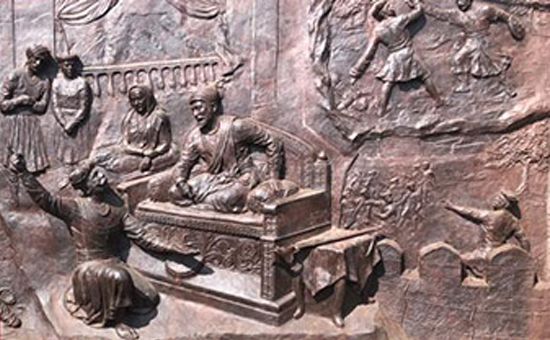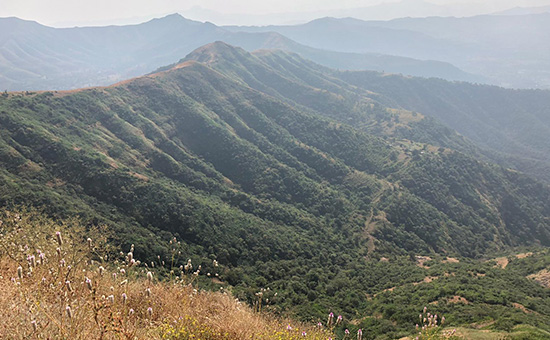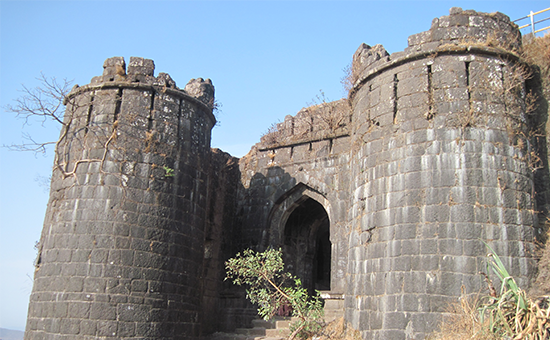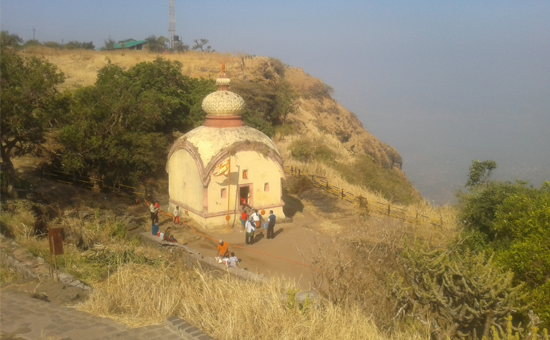- Historical films
are the flavour of the day and one of the films about to be released is a
biopic on Tanaji Malusare, the conqueror of the fort of Sinhagad in 1670.
While Tanaji is primarily known for his conquest of Snhagad, he was by then a senior commander in Raja Shivaji’s army and had already taken part in several missions. Originally from the village of Godoli near Panchgani, he had later moved with his family to a village named Umrathe near the fort of Pratapgad. He was instrumental in attacking Afzal Khan’s army after the famous meeting at Pratapgad and following it up with leading his contingent while winning fort after fort from the Bijapur sultanate. Many smaller battles in the Konkan area were also fought under Tanaji.
In 1642, the young Shivaji with his mother came to live in Pune, the jagir of Shahaji raja, who was then a high ranking noble in Bijapur. The fort of Sinhagad was part of the jagir and it is possible that both mother and son, may have lived on it for a while. In 1644, an attempt was made by Bijapur to take the fort, however Dadaji Kond-dev repelled it. However, it was probably lost soon after, Shivaji raja recaptured it. However, the Bijapur Adil Shah imprisoned Shahaji raja, bringing pressure on Shivaji raja, who then had to return it in exchange of his father’s liberty.
In 1656, the
Muhammad Adil Shah fell ill and died shortly afterwards. This afforded an
opportunity for Shivaji raja to capture Sinhagad once again. The importance of
the fort to safeguard the jagir of Pune could hardly be overstated. Along with
Purandar, this formed an important fort guarding the roads to Pune. Once it was
captured in 1656, Sinhagad remained with the Maratha ruler. For a while atleast.
Following Shivaji raja’s attack on Surat in 1664, the Mughal Emperor Aurangzeb, who was extremely disturbed by this invasion, dispatched one of the strongest Mughal armies ever assembled under Mirza raja Jaisingh against the Marathas. Jaswant Singh, a Rajput ruler placed the fort under a siege, but was chased away by the Marathas. Finally, Jaisingh laid siege to the strong fort of Purandar where Shivaji raja was based. A prolonged tussle ensued and at the end, Jaisingh managed to sign a treaty whereby the Mughals were handed over several forts including the fort of Sinhagad.
As the balladeer
recounts, the cession of this fort rankled Shivaji raja and his mother
Jijamata. The venerable lady tells her son,
'None of the forts that call thee lord,
Desire I, son, but seize thy sword;
By Poona in the distance dim,
Beyond Jejuri black and grim,
Near Poorundhur I see
The unconquer'd walls of Singhur shine,
O gods of power! if they were mine
Fulfill'd my life would be.'
The Maratha prince could not but please his mother.
However, it was also his own desire that Sinhagad be captured.
There was an enforced peace for a few years during which Maratha positions were strengthened. Aurangzeb had also tried to restrict Shivaji raja’s siege operations against Janjira - a feudatory of the Adil Shah. Again, Aurangzeb had tried to imprison Maratha officers at Aurangabad, which seemed an act of faithlessness. Further, between August and September 1669, Aurangzeb destroyed the Vishwanath temple at Varanasi. Aurangzeb had earlier issued an order to destroy temples in April 1669.
Finally, Shivaji
raja decided to go on the offensive, breaking the peace with the Mughals. The
target for the first attack was the fort of Sinhagad, and it was the most
daring.
At that time,
the fort was under a Rajput killedar named Udai Bhan, who was serving
the Mughals. The defence of the fort was quite rigorous usually, however, as a
peace between the Mughals and the Marathas prevailed for nearly four years now,
no attack was expected. Sinhagad was a tough fort to capture even otherwise
with its steep climb and sharp cliffs at the rear. Half way up the fort were
guard huts that kept a vigil on unaccounted visitors too. The task was
therefore, quite difficult for any attacking party.
However, the task was far from simple with the strong Udai Bhan as the killedar of Sinhagad. The balladeer Tulsidas puts this verse in Shivaji raja’s mouth,
‘Where,' cried he,
find a mortal man
To quell the Mogul Udebhan?
As demon fierce to meet his foe,
Strong as a god to lay him low!
What chief towards the tiger's maw
His hand will dare to thrust for awe?’
 Mural at fort. Pic by Ashish Patwardhan
Mural at fort. Pic by Ashish Patwardhan
Story goes that Tanaji goes to Shivaji to invite him for his son’s wedding. Shivaji asked him to take Kondana but says he can do it after his son’s weddings. Tanaji responds by saying first Kondana then my son Raiba’s wedding.
In early 1670, plans began to begin recapturing the twenty-three forts that Shivaji raja had been forced to cede to Mirza raja Jaisingh. It was decided that the first attack would be aimed at Sinhagad, the fort that was closest to Pune.
During the
planning, the anecdotes say, Tanaji picked the gauntlet to capture the fort
among the most prominent chiefs of the kingdom. He asked for just five hundred
men and decided that he would launch an attack only after proper surveillance
of the fort. It can be assumed that men may have been sent in disguise to
villages at the foot of the fort to gauge the level of security and the
alertness of the guards.
After this
survey, Tanaji decided that at the rear of the fort where the cliffs were the
most difficult to scale, the guards were thinly spread out and not quite
attentive.
The night of 4th
February saw the attack on Sinhagad. Stealth, secrecy
and a night attack were the key to success. Climbing a cliff was not difficult
as the mavalas – or the soldiers who came from the Maval region - were all agile, light and fleet footed. Their standard weapons were a sword and a shield.
The story of the ghorpad (Indian monitor lizard) is apocryphal. The lizard would find it hard not only to obey such commands but even to bear the weight of a man climbing on a rope affixed to its body. However, the myth lives on. It is mentioned that they used ‘maalas’ to climb, presumably rope ladders, carried ahead by two men who handed them to the next higher person, anchored the ladders securely to a rock or other firm place on the top and the rest of the team climbed up.
The nearest contemporary account of the capture is
given by Sabhasad. He says that once the decision was taken, Moropant Peshwa,
Annaji Pant and Nilo Pant were asked to win forts while mavalas led by
Tanaji were to attack Sinhagad. Tanaji took leave of his king and two mavalas
climbed the walls and fixed ropes on the top. With three hundred men Tanaji
climbed the rope to the top. There was some noise and Udaibhan was awakened,
thereby getting the twelve hundred strong Mughal and Rajput garrison to come to
the defence of the fort. The Mavala troops vigorously fell upon the defenders
so that nearly five hundred Rajputs were slain against a loss of fifty mavalas.
 View from the cliff that Tanaji climbed. Pic by Ashish Patwardhan.
View from the cliff that Tanaji climbed. Pic by Ashish Patwardhan.
During this, Tanaji came face to face with Udai Bhan and a duel began between them. Sabhasad says, ‘the shield held by Tanaji in
his left hand broke. Another shield could not be available and Tanaji then,
shielded himself with his left hand and fought. Both the warriors fought
bitterly. They received fatal injuries at the hands of each other. Tanaji and
Udaibhan fell dead.’
Meanwhile, the remaining two hundred men who were with Tanaji’s brother Suryaji had entered by overpowering the guards at the Kalyan gate of the fort. On Tanaji’s death, Suryaji rallied the men to keep fighting, killing the Rajput soldiers, some of who died by falling off the fort walls. Nearly twelve hundred Rajputs were killed and the remaining submitted, surrendering the fort.
 Kalyan Gate. Pic by author.
Kalyan Gate. Pic by author.
As a signal, a huge bonfire was lit at the stables in the fort. The fire was seen from Rajgad fort and Shivaji raja exclaimed ‘The fort has been taken! Victory has been achieved!’ However, the next day he received a message, ‘Tanaji Malusare fought a great battle. He killed Udaibhan, the custodian of the fort. Tanaji Malusare too lost his life. The fort was captured.’
The Raja remarked, ‘A fort has been taken, but one fort too has been lost.’ There was a lot of sorrow at this loss of a
valiant commander.
Suryaji was then appointed as the custodian of
Sinhagad. Gold bracelets were given as gifts to the soldiers. Sinhagad was of
course, only the first of many forts captured in 1670. Over the next four
months before the monsoon, Purandar was captured in March by Nilo Pant.
Chandor, Kalyan, Bhiwandi, Mahuli in the Konkan were also attacked. Maratha
armies spread into present day Marathwada.
Finally, Shivaji raja attacked Aurangzeb’s vanity by attacking and looting the rich city of Surat a second time. A
letter from the Governor of Surat gives the rationale for the loot stating, ‘As your Emperor has forced me to keep an army for the defence of my people and my territory, that army must be paid by his subjects. If you do not send me money speedily, then make ready a large house for me, for I shall go and sit down there and receive the revenue and custom duties, as there is no one now to stop my passage.’
The capture of
Sinhagad by a daring night raid with an army much smaller than the defending
garrison must rank as one of the most daring exploits in military history. It
is rare indeed for the attacking army to have far fewer casualties even in
modern warfare.
In those times,
it was the spirit and verve and energy of their leader Tanaji that enthused the
small band of men to make the successful beginning of a campaign against the
Mughals, that eventually culminated in
the coronation of Chhatrapati Shivaji in 1674.
Of Tanaji’s stirring deed, Tulsidas says,
‘And ye, Marathas brave! give
ear,
Tanaji's exploits crowd to hear.
Where from your whole dominion wide
Shall such another be supplied?
O'er seven and twenty castles high
His sword did wave victoriously.
The iron years are backward roll'd,
His
fame restores the age of gold…’
To
read all articles by author
 Samadhi of Chhatrapati Rajaram who died here in 1700. Pic by author.
Samadhi of Chhatrapati Rajaram who died here in 1700. Pic by author.